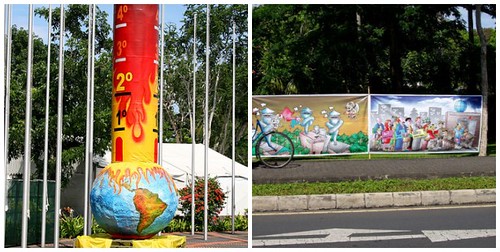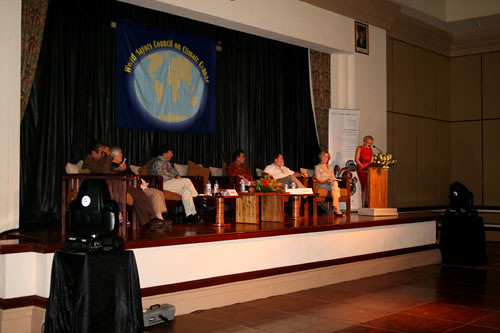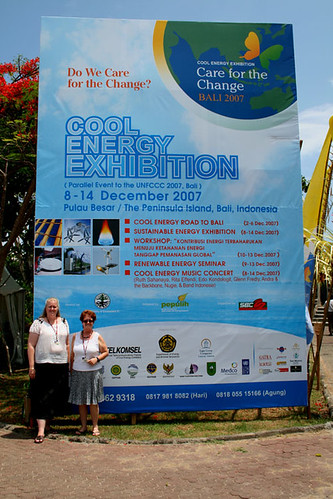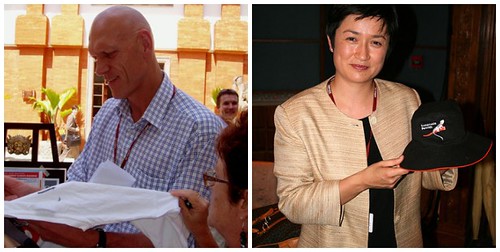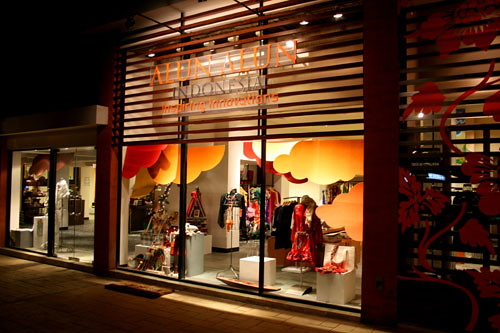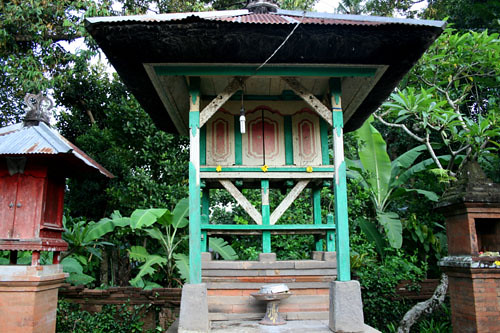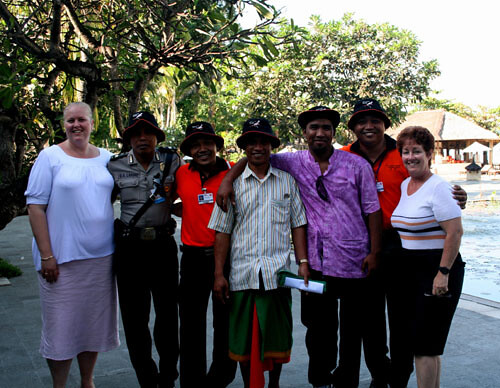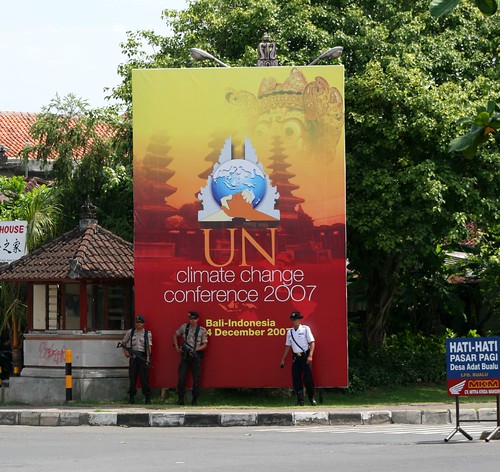 Best wishes to all for a wonderful (and sustainable) Christmas. Why not try this festive silly song, sung to the traditional tune!
Best wishes to all for a wonderful (and sustainable) Christmas. Why not try this festive silly song, sung to the traditional tune!Monday 24 December 2007
Wishing You and Yours a Merry Christmas
 Best wishes to all for a wonderful (and sustainable) Christmas. Why not try this festive silly song, sung to the traditional tune!
Best wishes to all for a wonderful (and sustainable) Christmas. Why not try this festive silly song, sung to the traditional tune!Friday 21 December 2007
Christmas Edition of the Sustainability Street Newsletter Out Now!

The Christmas edition of the Sustainability Street Newsletter is out now. Click here to download your copy. The newsletter is full of updates on what our six Sustainability Streets have been up to, including:
- Have a Merry (& Sustainable) Christmas!
- Upcoming Street Dates
- Sustainability Streets Take on Water
- Greywater...No longer a grey area
- Water Efficiency Labelling for Household Appliances
- Make Yours a Green Christmas
- Australia Ratifies Kyoto Agreement
- Give the Environment a 'Happy New Year'
- Fresh Manure Available
If you would like to be added to the electronic mailing list for this newsletter send a quick email to Carmel Hamilton.
Thursday 20 December 2007
TT Postcard from Bali

Like any postcard it arrives after you have returned home.
1….Concerns over safety were quickly dispelled, with security checkpoints aplenty. Bag checks were a daily ritual, with registration required on the first day. We were lucky enough to complete the registration process early, before the queues below took place. Not fun in the heat and extreme humidity.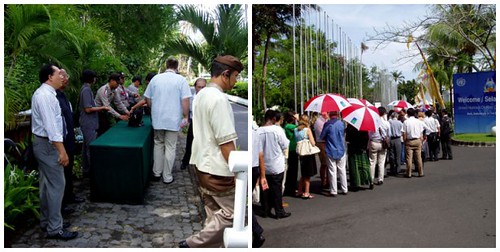
UNFCCC Entrance, originally uploaded by penrithsustainabilityunit.
2…. An invitation to the Governor of Bali's residence provided a taste of Bali's rich culture.
1. Entrance Dance, 2. Govenors backstairs, 3. Staff and Performers, 4. Delegates on stage
3…. Amazing displays were scattered between the conference centres.
1. Global Thermometer, 2. Posters
4…. The Local Government sessions were held concurrently with the the UNFCC Conference in the Old Convention Centre.
5…. The Cool Energy Exhibition was held on the Peninsula Island a short but hot walk from the Old Convention Centre. A two hour lunch break enabled us to take in exhibits from a range of organisations including Unilever who were promoting a program similar to our Sustainability Street program, United Nations Environment Program, and various Indonesian government departments amongst many others.
6…. For every thumbprint a tree was to be planted.
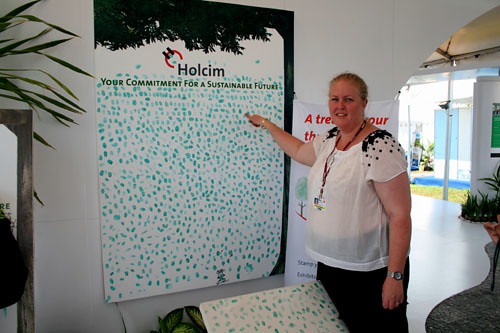
Holcim Tree Thumbprint, originally uploaded by penrithsustainabilityunit.
1. Solar v Normal Taxi, 2. Solar Taxi Trailer
8…. The main stage for the conference, we arrived early so that we could hear Senator Penny Wong give her address.
9…. 'Polly' spotting, we managed to give Minister Peter Garrett, and Senator Penny Wong each a Sustainable Penrith hat.
1. Peter Garret, 2. Penny Wong with SP hat
10…. To help delegates get around bikes were available free of charge.
1. UNFCCC Free Bikes, 2. UNFCCC Free Bike
11…. Not quite the street stalls synonymous with Bali, this store was more high end, however, it is interesting as it was started by the former Minister of Culture and Tourism, and celebrates the works of Indonesian artists and craftpersons, both those who are already famous and those living hidden away in remote rural areas who are producing extraordinary works.
13…. We appreciated the friendship provided us by the 'friendly' police, guides and drivers that made sure we got to and from the conference on time and in one piece, whilst teaching us a lot about Bali.
The purpose of the meme is to get to know everyone who participates a little bit better every Thursday. Visiting fellow Thirteeners is encouraged! If you participate, leave the link to your Thirteen in others comments. It’s easy, and fun! Trackbacks, pings, comment links accepted!
Wednesday 19 December 2007
Monday 17 December 2007
It's a disposable world
Once upon a time things were designed and manufactured to last, and if they did break they were easily repaired. The construction of new ‘things’ requires an enormous amount of energy input, resource extraction and man hours. Whilst the price for a new item may be cheaper this price tag does not represent the whole cost of the item.
Not only are we purchasing items that are of poor quality and will need replacing in a short period of time, we are also increasingly purchasing items of little need, “want items”, that often go unused. Infact, it is suggested that Australian’s spend over $10.5 billion dollars annually on unused items (Hamilton et al 2005) and that trend is increasing.
2 dollar shops are thriving and we are consuming more and more without realising the deeper and ongoing consequences. We as a race seem to be caught up in the cycle of “things”. We like
 new “things”, lots of “things”.
new “things”, lots of “things”.Whilst we are becoming more aware of the need to recycle most people have not yet grasped the ‘reuse is better than recycle’ theory. For example, statistics show that Australians change their phones every 12-18 months, with only 4% recycling their old phones (Phillips 2007). TVs, DVDs, household appliances, stationary, computers, houses, clothing, nappies are other notable areas where items are over consumed and/or wasted, with food highest on the waste list (Hamilton et al 2005).
So the next time you are looking to buy something think about the ongoing costs, perhaps it is better to buy it once and buy it properly rather than settling for the ‘cheap’ disposable item. And, next time you go to get rid of something ask the question “would anyone else benefit from the use of this item?” and think about the ways it could be reused. Remember: “one person’s trash is another person’s treasure”, sell your unused items online (Freecycle, E-bay, Grays Online, Trading Post, interest forums) or donate them to charities. Most importantly: use everything that you buy.
Phillips, S. eds. 2007, G Magazine, Luna Media, Chippendale, Australia.
Sydney Morning Herald. 11 March 2007, http://www.smh.com.au/news/national/drastic-plastic-bag-ban-looms/2007/03/10/1173478729172.html
Tuesday 11 December 2007
Local School Kids Pass the Solar Challenge!
 Last Wednesday, 5 December 2007, Council held a special presentation ceremony to recognise and celebrate the wonderful achievements of local school studnets in the recently completed Solar Boat Challenge. This year the Penrith area was well represented at the Challenge with 11 teams from the immediate Penrith area taking part, along with another 7 from the wider Blue Mountains and Hawkesbury area.
Last Wednesday, 5 December 2007, Council held a special presentation ceremony to recognise and celebrate the wonderful achievements of local school studnets in the recently completed Solar Boat Challenge. This year the Penrith area was well represented at the Challenge with 11 teams from the immediate Penrith area taking part, along with another 7 from the wider Blue Mountains and Hawkesbury area.It's fair to say that each of the individual school students and teams passed the challenge, with flying colours. There were some great results from the teams including:
Primary School Wire Guided Division:
- 1st place overall - Emu Heights Public School
- 1st place in the racing component - Colyton Public School
- 2nd place in the racing component - Claremont Meadows Public School
- 1st place overall and 2nd place in the racing component of the State Primary Remote Controlled Division - Lapstone Public School
- 3rd place overall and 2nd place in the racing component of the Secondary Wire Guided Division - Colyton High School
State Secondary School Remote Controlled Division:
- 2nd place overall in the Secondary Remote Controlled Division - Springwood High School
- 3rd place in the racing component of the Secondary Remote Controlled Division - Caroline Chisholm College
 Prizes and certificates were also awarded in other areas including graphic and technical design, and presentation.
Prizes and certificates were also awarded in other areas including graphic and technical design, and presentation.Lapstone Public School, Winmalee High School, Springwood High School and Penrith Anglican College all received certificates for their graphic design skills while Lapstone, Springwood, Penrith High School and Penrith Anglican College all picked up certificates for their technical design.
The schools also did a great job on the presentation side of things with special mentions for Lapstone Public, Winmalee High School, Glenmore Park High School, Arndell Anglican College, Cranebrook High School, Claremont Meadows Public, and Caroline Chisholm College all picking up awards or certificates in this area.
Schools that participated are listed below. Click on the individual schools for a case study of how they tackeld the Challenge.
Primary Schools:

Claremont Meadows Public School
Colyton Public School
Emu Heights Public School
Lapstone Public School
Secondary Schools:
Arndell Anglican College
Colyton High School
Cambridge Park High School
Caroline Chisholm College
Cranebrook High School
Doonside Technology High School
Glenmore Park High School
Hawkesbury High School
Master Coaching, Richmond
Nepean High School
Penrith Anglican College
Penrith High School
Springwood High School
Winmalee High School
Visit Council's website for more information.
Monday 19 November 2007
Plants are Amazing- Series Two
 Well I hope you have all been admiring the many amazing adaptations that plants have developed to cope with the harsh Australian climate in your gardens or while bushwalking, and have possibly noticed a few more structural features that plants have and maybe questioned the reasons why they have these features. Detailed below are some more amazing features that you may have noticed along your tracks.
Well I hope you have all been admiring the many amazing adaptations that plants have developed to cope with the harsh Australian climate in your gardens or while bushwalking, and have possibly noticed a few more structural features that plants have and maybe questioned the reasons why they have these features. Detailed below are some more amazing features that you may have noticed along your tracks.As you walk around the garden or along your bushwalks you will see numerous examples of leaf adaptations designed to cope with low rainfall, searing summer temperatures, or saline soils. Examples of leaf adaptations include short, leathery leaves which have reduced surface area to minimise evapotranspiration (water loss due to evaporation). Other examples are terete (tubular leaves), spiky or in rolled leaves. Look at the leaf structure of Spinifex plants. Wattles have phyllodes (modified stem structures) instead of true leaves- this is believed to be a response to our infertile soils, rather than to the dry, hot climatic conditions.
Some heat defecting modifications of leaves include the presence of stellate (star-shaped) or branched hairs, scaly or waxy cuticles (outer surface of leaves), and the blue-grey colouration of many plants. Many of the Emu Bushes have hairy stems or leaves, and many of them are also blue-grey coloured. Saltbushes are well represented in arid regions in Australia, and many of these have scaly or hairy foliage, as well as succulent leaves (water-storage), and vesicle structures on their leaves to assist with salt exclusion for survival in saline soils.
Another leaf modification some plants have to limit evapotranspiration is the placement of stomata (the structure where gas exchange occurs) - some plants limit these to the underside of leaves, while others have their stomata hidden in pit-like structures, often covered by fine hairs.
The orientation of leaves in plants is often with the leaf edge turned toward the sun in order to reduce the surface area impacted on by evaportranspiration. Look for this feature in some wattle species.
Stem modifications are also apparent in some plant species to help them survive the harsh climate. Mallees are multi-stemmed gum trees (Eucalyptus species) that have modified stem base called a lignotuber which allows the trees to sprout again after severe drought or fire has killed off the top growth. Multiple growth points under the bark of trunks of many Eucalypt species allow them to re-sprout along their trunks after fires.
Stay tuned over the next fortnight for more amazing plant adaptations.
Imaged sourced from Botanical Gardens at the University of California, Los Angeles (UCLA)
Monday 12 November 2007
Penrith Walks Against Warming
 More than 100 people turned up to Weir Reserve in Penrith to lend their support to the walk, which aims to increase awareness of the issue of climate change and global warming among all levels of the community.
More than 100 people turned up to Weir Reserve in Penrith to lend their support to the walk, which aims to increase awareness of the issue of climate change and global warming among all levels of the community. It was a leisurely stroll alongside the beautiful Nepean River with most people stopping to pick up a temporary tattoo to mark the day!
It was a leisurely stroll alongside the beautiful Nepean River with most people stopping to pick up a temporary tattoo to mark the day!  After getting back to Weir Reserve there was plenty of time (and space) to relax with a sausage sandwich and cold drink thanks to the Penrith Lions Club and to pick up a free native tree to take home and plant in the garden.
After getting back to Weir Reserve there was plenty of time (and space) to relax with a sausage sandwich and cold drink thanks to the Penrith Lions Club and to pick up a free native tree to take home and plant in the garden.  All in all it was a great day that I'm sure will be bigger and better in 2008!
All in all it was a great day that I'm sure will be bigger and better in 2008!Friday 2 November 2007
Penrith Walk Against Warming

Come along and show your support by walking with us for a short way along the Great River Walk. Meet near the rotunda in Weir Reserve (off the Great Western Highway) at 10am and if you are one of the first 100 to arrive you can also pick up a free sausage sizzle and native plant!
We need your help to get the message out there so if you would like some posters (A4 or A3) or postcards to distribute at your school, church or in your neighbourhood contact Carmel Hamilton on 02 4732 8050.
Hope to see you there!

Monday 22 October 2007
Plants are Amazing- Series One
Within the Western Sydney region plants have to contend with low, highly variable rainfall, high summer temperatures, relatively frequent wildfire events, and infertile soils. These plants have adapted to these conditions be evolving a suit of structural, biochemical or growth response adaptations.
One way that plants have adapted to this is with special root system modifications. Root adaptations include the development of water storing roots in plants such as Mallees. Structural and biochemical changes in these plants allow the roots to store supplies of water harvested after big rain events, so that these plants can survive better during long drought periods. Other plants have modified root systems called tubers where stores of nutrients are held, allowing the above ground part of these plants to die off during drought times and then regrow after rain.

Some other species (for example Hakeas and Grevilleas) have root modifications (called proteoid roots) that allow them to extract phosphorous from our low fertility soils. Many legumes (wattles, pea family plants) have evolved a relationship with nitrogen-fixing bacteria that amass in nodules along their roots and make atmospheric nitrogen available to plants after the host plants has died.
Each fortnight, as part of the ‘Plants are Amazing’ series, another adaptation will be revealed, so stay tuned in the coming weeks for more cool adaptations our plants have developed.
Monday 15 October 2007
Start at home - Save the Earth!
Read below for some easy tips on saving the planet by starting at home. If you are already doing all of these - congratulations! Send in your own tips for sustainable living and we'll also post them on our Sustainable Penrith website.
- Providing enough space for circulation around the fridge, and locating your fridge away from the sun and your oven can result in big energy savings.
- Make sure that your door seals are clean and that the door closes properly.
- Buy energy efficient appliances when you need to replace an item.
- Switch all of your kitchen appliances off at the wall when they aren't in use.
- Wait until the dishwasher and washing machine are full before use
In Your Living Areas
- Switch to energy saving lights like compact fluorescents to save up to 80% of your lighting energy.
- Use light coloured paint outside your home to reflect, rather than absorb, light and heat.
- Standby power for televisions, videos and stereos can account for 11% of a household electricity bill. Turn them off at the power point.

- Insulate ceilings and walls to reduce heat loss in winter and to keep the house cool in summer.
- Protect your windows with curtains and blinds.
In Your Bathroom & Laundry
- Install AAA rated showerheads and tap fittings to save water and energy.
- Brighten rooms with a skylight rather than a light bulb.
- Buy a water and energy efficient washing machine.
- Use cold water for washing clothes.
- Use the clothes line to dry clothes.
- Walk or ride your bike instead of using a car.
- Catching public transport.
- When buying a car, buy a fuel efficient one. See the Green Vehicle Guide http://www.greenvehicleguide.gov.au/.
- Carpool. When at work find out who lives near you, better still try to establish a carpooling group and post up on notice boards. This can save you money and is a great way of meeting people. It also helps the environment.
- Drive smoothly, don't stop and start too many times and avoid hard braking.
Thursday 11 October 2007
Eat locally, save globally
Then I started to think about the route of the blueberries from the farm to my toast. Most likely my blueberries were trucked from the farm where they were grown to the airport where they were transferred to a plane where they travelled up to 21322 kilometres (5525km from Canada) to France. Upon arrival in France they were unloaded from the plane and trucked to the jam factory where they were made into jam. Once converted to jam, my blueberries began the lengthy journey to Australia. Back on the truck, transferred to ship or plane, transferred to a truck, sent to a distribution warehouse, transferred to a truck and on to the shelves of the supermarket where I take them, in my car, to put on my toast.
There are huge fossil fuel requirements associated with international food transport, and the question that should be raised is: are all of the movements necessary? With the looming issue of climate change it is about time we placed a greater focus on local produce.
Living in the Penrith local government area we are blessed with a vast array of locally grown produce. By purchasing locally grown and manufactured produce you are ensuring freshness,
 local economic viability, and you can save the resources required to send produce to the other side of the world. So the next time you are in the supermarket have a look at where your produce is grown and manufactured. Buy Australian produce and reduce the number of kilometres travelled by your food.
local economic viability, and you can save the resources required to send produce to the other side of the world. So the next time you are in the supermarket have a look at where your produce is grown and manufactured. Buy Australian produce and reduce the number of kilometres travelled by your food.In 2000 a group of local people developed Hawkesbury Harvest which promotes locally grown produce. To find out where and what local produce is available visit www.hawkesburyharvest.com.au. A great way to discover what the region has to offer is to pack a picnic and take a leisurely drive along the The Farm Gate Trail.
Another great option for purchasing locally grown produce (as shown in the photo) is to buy from local produce markets. Several markets can be found in the Sydney metropolitan area:
- Camden Produce Market: Lower John St, Camden - 2nd and 4th Saturday of each month, 7am to 12noon
- Cobbitty Village Market: Cobbitty Public School, Cobbitty Road, Cobbitty - 1st Saturday of each month (except Jan & Feb), 8am to 1pm
- Fox Farmers' Market: Fox Studios - Every Wednesday, 10am to 4pm
- Good Living Growers Market: Pyrmont Foreshore - 1st Saturday of each month, 7am to 11am
- Hawkesbury Harvest Farmers & Gourmet Food Market: Castle Hill Showground, Showground Rd enter via Carrington Rd, Castle Hill - 2nd Saturday each month, 8am to 12noon
- Hornsby Organic Food & Farmers Markets: Hornsby Mall - Every Thursday, 8am to 4pm
- Hurstville Organic Food & Farmers Market: Cnr Forest Road and Durham Street - Every Sunday, 9am to 2pm
- Kings Cross Organic Food & Farmers Market: Fitzroy Gardens, Macleay Street, Elizabeth Bay - Every Saturday, 8am to 2pm
- Leichhardt Organic Food & Farmers Market: Orange Grove Public School, Cnr Perry St & Balmain Rd - Every Saturday morning
- Marrickville Organic Food & Farmers Markets: The Addison Road Community Centre, Addison Road, Marrickville - Every Sunday, 8:30am to 2pm
- Penrith Market: Penrith Showground - Every Wednesday
- Sydney Fresh Food Market: Sydney Markets, off Parramatta Road, Flemington - Every Saturday, 6am to 2pm
- Warwick Farm Trackside Market: Warwick Farm Racecourse, Governor Macquarie Drive, Warwick Farm - Every Saturday, 8am to 12noon
For more information on produce markets check out the Australian Farmer’s Markets Association website: http://www.farmersmarkets.org.au/.
Wednesday 10 October 2007
Latest Sustainability Street Newsletter

The October Sustainability Street Newsletter is out now. Click here to download your copy.
The newsletter is full of updates on what our six Sustainability Streets have been up to, including:
- Spring into Veggies
- Upcoming Street Dates
- Magical Mini Bus Tour
- Sustainability Street Energy Stars
- Sustainability Streets Have the Energy!
- Solar Boat Challenge: State & National Finals
- Rebates Available for Insulation and Hot Water Systems
- Website of the Month: G Magazine
If you would like to be added to the electronic mailing list send a quick email to Carmel Hamilton.
Monday 8 October 2007
A Great Opportunity - New Rebates Available!
 Some great new rebates have just been announced by the NSW State Government to help householders offset some of the costs of installing energy efficient hot water systems and ceiling insulation.
Some great new rebates have just been announced by the NSW State Government to help householders offset some of the costs of installing energy efficient hot water systems and ceiling insulation. Wednesday 19 September 2007
September Sustainabilty Street Newsletter Out Now

- Upcoming Street Dates
- Mulgoa's Waste Line Looks Good!
- Get a Smaller Bin and Save $$$!
- Sir John Jamison Circuit Reserve Gets a Facelift
- Banool Avenue Garden
- Remember the Waste Shortcut
- Website of the Month: Freecycle
- Hawkesbury EarthCare Fair - Living Green
- Magnetic Places Community Cultural Grants Program
- Complete an Online Survey and Win!
Tuesday 18 September 2007
Magical Minibus Tour of Green Homes
 The group seemed particularly impressed with his organic vegie patch and moving chook tractor, which was designed so that it would fit directly on top of one of the garden beds. This means he can move the tractor around the yard and over the various garden beds to allow the chooks to do their thing - fertilising the soil and giving it a thorough working over!
The group seemed particularly impressed with his organic vegie patch and moving chook tractor, which was designed so that it would fit directly on top of one of the garden beds. This means he can move the tractor around the yard and over the various garden beds to allow the chooks to do their thing - fertilising the soil and giving it a thorough working over! Nevin and Linda also have a greenhouse where they can raise the seed that they have collected from their gardens. Further proof of their ingenuity is the use of old cardboard rolls as seed raising pots. Once the seedlings are big enough these can be planted straight into the ground as the cardboard will break up over time! An excellent way to reuse waste products and compost them at the same time!
Nevin and Linda also have a greenhouse where they can raise the seed that they have collected from their gardens. Further proof of their ingenuity is the use of old cardboard rolls as seed raising pots. Once the seedlings are big enough these can be planted straight into the ground as the cardboard will break up over time! An excellent way to reuse waste products and compost them at the same time! Sadly we had to keep moving along to visit the next sustainble house - this time at Rooty Hill. When we arrived there was already a large number of people gathered round and listening to the owner, Rob, talk about his solar panels - so we joined the group. It's amazing to think that most of the time Rob can generate enough electricity from his solar panels to power his own home, and now that the Federal Government has increased the rebates for installing these panels this technology is becoming more affordable.
Sadly we had to keep moving along to visit the next sustainble house - this time at Rooty Hill. When we arrived there was already a large number of people gathered round and listening to the owner, Rob, talk about his solar panels - so we joined the group. It's amazing to think that most of the time Rob can generate enough electricity from his solar panels to power his own home, and now that the Federal Government has increased the rebates for installing these panels this technology is becoming more affordable.  Rob showed us around his yard and home and pointed out the various items that he has had installed to 'green' up his home - he has the solar panels, a passive heating device called a Sun Lizard, rainwater tanks, solar hot water and more!
Rob showed us around his yard and home and pointed out the various items that he has had installed to 'green' up his home - he has the solar panels, a passive heating device called a Sun Lizard, rainwater tanks, solar hot water and more!  It was then time to continue on our journey and so we headed out to Richmond for a picnic lunch in the grounds of the Hawkesbury EarthCare Centre. We were all desperate for a sandwich and a drink by this stage - although some of the group seemed more desperate for a caffeine hit than others!
It was then time to continue on our journey and so we headed out to Richmond for a picnic lunch in the grounds of the Hawkesbury EarthCare Centre. We were all desperate for a sandwich and a drink by this stage - although some of the group seemed more desperate for a caffeine hit than others! Once our tour of the building was complete we headed off to the permaculture garden, which is looked after by the Henry Doubleday Research Association. The garden has been designed using traditional permaculture principles, and provides a range of aspects within the garden so that a suitable spot for any plant can be found. It looked great and was a lot of fun to wander around! You can visit the EarthCare Centre yourself on any of its open days throughout the year - they have an EarthCare Fair coming up on Saturday 22 September.
Once our tour of the building was complete we headed off to the permaculture garden, which is looked after by the Henry Doubleday Research Association. The garden has been designed using traditional permaculture principles, and provides a range of aspects within the garden so that a suitable spot for any plant can be found. It looked great and was a lot of fun to wander around! You can visit the EarthCare Centre yourself on any of its open days throughout the year - they have an EarthCare Fair coming up on Saturday 22 September.  Next up we were back on the bus again - trusting our friendly bus driver Peter to take us home after a fun and interesting day.
Next up we were back on the bus again - trusting our friendly bus driver Peter to take us home after a fun and interesting day. 
Thursday 13 September 2007
Thursday Thirteen #1 The Eastern Water Dragon

1…. It’s the mascot of Penrith City Council’s Sustainable Penrith Program.
2…. The Eastern Water Dragon is Australia’s largest ‘dragon’ lizard with males measuring around 30cm from their snout to the end of their body and females measuring around 23cm.
3…. Water dragons are semi-aquatic lizards that are at home both in the water and on land. Because of this water dragons like to live close to creeks, rivers and other sources of water – like a garden pond.
4…. Male water dragons get a red patch on their chests when they mature which makes them easy to distinguish.

5…. Male water dragons are territorial and will defend their territory. They can do this by:
- sitting with their red coloured chests out to warn off other water dragons;
- pushing other males off logs;
- lying alongside each other and then turning rapidly to bite their opponent; or
- bobbing their head which communicates to other males that this is their territory.
6…. Water dragons eat insects, frogs, yabbies, water bugs, fruit and berries. They are clever things – they grab the insects out of the air with their mouths and manage to catch other food, like frogs and yabbies, while swimming under water.
7…. Their scientific name is a bit tricky to pronounce – Physignathus lesuerii.
8…. Water dragons can be preyed upon by snakes so they often sleep on branches overhanging the water. If they sense danger they can drop straight into the water - you will often hear the noise of water dragons jumping into water as you walk along a creek or river bank.
9…. Females can lay up to 20 eggs at a time during October through to December with the hatchlings appearing from January through to March.
10…. Water dragons can live for a surprisingly long period of time – 25 to 28 years!
11…. Water dragons have very sharp claws.
12…. Water dragons can remain underwater for up to an hour and can be seen ‘sleeping’ submerged in the water with only their nostrils protruding.
13…. In Chinese mythology the Water Dragon is a symbol of well-being and prosperity.
The purpose of the meme is to get to know everyone who participates a little bit better every Thursday. Visiting fellow Thirteeners is encouraged! If you participate, leave the link to your Thirteen in others comments. It’s easy, and fun! Be sure to update your Thirteen with links that are left for you, as well! I will link to everyone who participates and leaves a link to their 13 things. Trackbacks, pings, comment links accepted!![]() thursday thirteen
thursday thirteen
Friday 24 August 2007
Kurrajong Eco Fair Coming Soon
Monday 20 August 2007
Free Tickets to Sustainable House Day 2007

Why not pop along on Saturday 8 September between 10am and 4pm and check some of these features out for yourself?
For more information visit the Sustainable House Day website at http://www.solarhouseday.com/.

